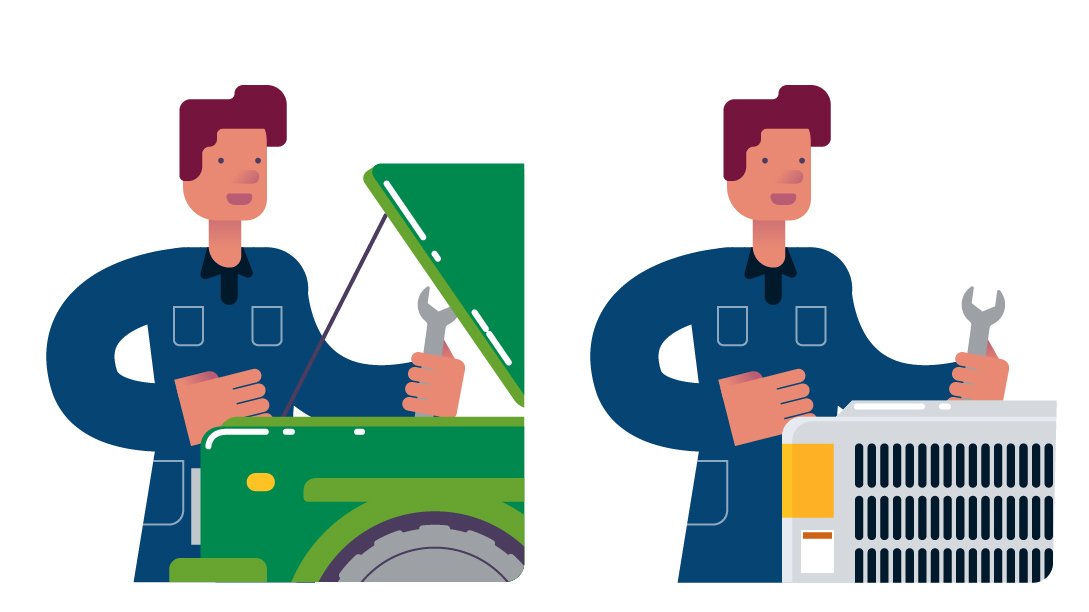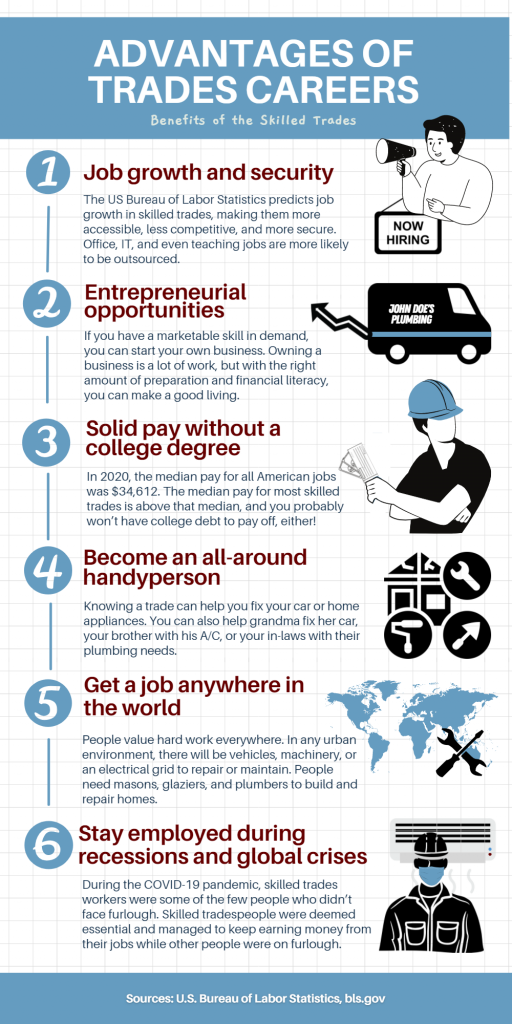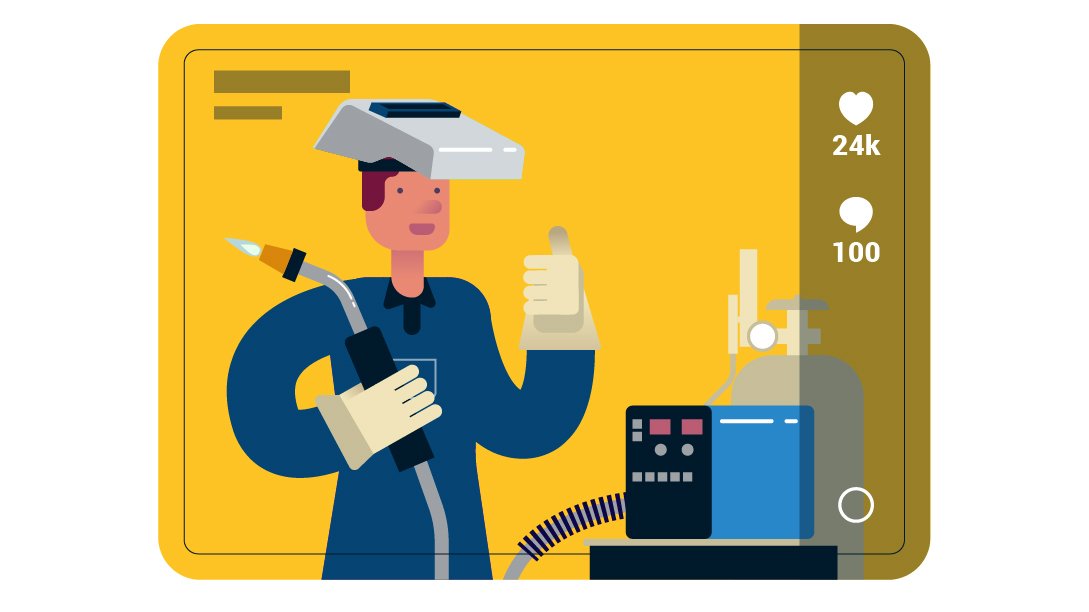Get Tech Tips
Subscribe to free tech tips.
An Argument for the Trades as a Viable Career Path

“What do you want to be when you grow up?”
“Where will you go to college?”
Young people hear those questions all the time. Although we ask those questions in good faith, they also carry a burden of expectations.
By asking those questions, we imply that we expect the children to go to college and set a “prestigious” career goal, such as becoming a doctor or lawyer. While we want to see our kids make a good living with a high-paying profession, the truth is that not everyone will benefit from the schooling required for those careers.
Also, unless your kids happen to check off the right boxes for scholarships, grants, or work-study programs, they’ll be saddled with debt for years. Some people do well in school, get lucky enough to get a job relevant to their degree, and manage to get a positive ROI.
However, college is a much riskier investment than people realize. That's especially true if a child doesn’t know if college is right for them. In the words of Mike Rowe, “At some point, cost and value diverge, and reasonable people start to question the wisdom of assuming a debt that will take decades to repay.”
However, one of the most viable career pathways doesn’t require college at all. A career in the skilled trades requires far less (if any) postsecondary education, eliminating the prospect of crippling student loan debt. Many skilled trades also have projected job growth, pay well, and are “essential” jobs.
I argue that the skilled trades offer several overlooked but viable career paths. I also believe that many young people will find more financial security and personal fulfillment from learning a trade than getting a traditional college education.

Skilled trades in the shadow of traditional “STEM” careers
When kids spend a lot of time playing with Legos and building model cars, we often hear adults say, “They’ll be an engineer when they grow up!”
Engineers are usually the ones who spend time drawing out plans and doing math at desks. The people who actually DO the thing are generally skilled workers. Within the trades, there is a ton of room for technical knowledge and curiosity; those qualities don't only belong to high-profile engineering careers.
For many people, that “hard work” is a way to get their minds and bodies engaged. Working with their hands is an outlet for their craftsmanship, and they can see the fruit of their work. They can feel satisfied knowing that their own hands repaired or installed something that made a difference for someone.
So, even though I think our expectations usually come from a good place, they are perhaps misguided. I think we’d see a lot more tradespeople if we saw a kid fixing a toy car and told her, “You could be a great auto mechanic someday.”
Projected job growth in the skilled trades

When we consider career paths, we want to see some degree of growth. A teenager who will enter the workforce in a few years will want to make sure there’s a spot for them to get a job. People who already have a career will want to make sure their skills remain in demand for job security reasons.
Let’s look at a “prestigious” profession first.
According to the Bureau of Labor Statistics (BLS), physicians and surgeons (“doctors”) have a projected 3% job growth between 2020 and 2030. That’s quite a bit below average (6-7%). However, the percentage is only part of the picture; we must also consider the total new jobs and the competitiveness of a career path. Because there are about 727,000 physician and surgeon jobs as of 2020, we can expect just under 25,000 new jobs to pop up over the next 10 years.
Because medicine is a competitive field, the slow job growth can be a bit concerning for prospective physicians. They may not get their return on the money and time invested in medical school, at least not for several years.
However, when we look at a career as an HVAC/R technician, we don’t have to account for the money and time spent on a degree. (For what it’s worth, the projected growth rate for that field is 5%, with an estimated 19,000 new jobs by 2030.) Those jobs are also likely less competitive, with many blue-collar workers aging out of the trade and reduced interest from millennials.

Technological innovation leads to growth opportunities
Other skilled trades show promising (if not astronomical) projected growth, especially in growing industries. For example, industrial machinery mechanic jobs have a projected increase of 19% for a total of over 95,000 new jobs. (Industrial engineers only have a projected increase of 14% and 40,000 new jobs.)
Also, as we use more renewable energy and require skilled tradespeople to install and maintain those energy sources, we can expect job growth to explode. For example, wind turbine technician jobs are expected to increase by 68% by 2030. Since so many skilled trades require us to work with our hands and troubleshoot machinery, we can also transfer our skills across industries (and perhaps earn higher wages).
Robot-proof professions

We are in the age of automation, and that’s something we’ll need to consider as we embark on new careers or encourage our children to choose careers.
Some people may worry that some skilled trades may be slated for automation, especially those that deal with machinery. Many of us have seen the 2005 film Charlie and the Chocolate Factory where Mr. Bucket gets laid off from capping toothpaste tubes because a robot could do his job.
Spoiler alert: He gets a better-paying job as a repair technician for the machines that took his first job.
Unlike some unskilled jobs, skilled craftsmanship requires human dexterity and intelligence. The jobs that are most likely to be automated don’t require troubleshooting, craftsmanship, or physically getting into the places machines are to repair them.
According to a 2013 Oxford University study, the American jobs most likely to be automated include telemarketers, title examiners, hand sewers, and mathematical technicians. Each of those jobs had a 99% chance of automation in 2013, and it’s probably no surprise. Most of us can think of commonplace technologies that can help automate these jobs: answering machines, search engines, sewing machines, and calculators.
As admitted by the researchers, the methodology of the study relies on some subjective criteria that are difficult to quantify (including “creativity;” I think most tradespeople would consider their work “art”). However, one thing stands out about the results and background research of the study: service occupations with manual tasks are at low risk of automation because they require a uniquely human combination of problem-solving and adaptability.
Many of the skilled trades also require us to see, hear, touch, and even smell abnormalities with machinery, building materials, and more. While robots can potentially detect and troubleshoot problems they have been programmed to fix, they don’t have “senses” that are as acute and adaptable as ours. This idea actually came up in a conversation I had with Adolfo Wurts on a podcast back in 2017. If you want to listen to that discussion, you can find it HERE.
All that said, I think we will see manufacturing and unskilled stationary service occupations go by the wayside far before the skilled trades.
Transferable skills

We can think of skilled tradespeople as artisans. A tradesman is a lot like a marble sculptor. If a sculptor decided to work with slate, he’d have to treat it differently from marble, but he’d use the same overall skillset and some of the same techniques.
It’s a very similar story for skilled tradespeople; someone who starts as an HVAC technician can transfer their skills to a different but similar position as a controls or refrigeration technician.
I own an HVAC, refrigeration, electrical, and construction business, and we encourage people who have experience working on cars or tinkering with other machinery to apply for jobs as apprentices. Although some positions require certification, many skilled trades employers understand that skills and trainability are what really matter, not degrees and other credentials.
So, tradespeople with widely applicable skills and experience can make lateral moves to other trades that might better fit their lifestyle. Having a solid foundation of mechanical skills opens up many doors for better-paying jobs or ones with more manageable hours.

Good living wages
Are you going to get rich automatically by working in the skilled trades? No. Can you earn a solid living just by working as a tradesperson? Absolutely. Keep in mind that the OPPORTUNITY to use the trades as a springboard to very high compensating jobs and even owning your own business is a reality.
According to the U.S. Bureau of Labor Statistics, the 2020 median annual pay for an HVACR technician or installer is $50,590. Let’s compare that to the Social Security wage data for the median annual salary in the entire United States in 2020: $34,612. So, the median HVACR technician salary is around $16,000 above the national median.
The median annual pay for an automotive service technician in 2020 was $44,050, which is still over $9,500 above the national median. Line installers and repairers, who work on power lines and fiber optics, had a median salary of $68,030 without postsecondary education requirements. That’s nearly double the national median!
Some jobs that require a college degree don’t pay anywhere close to that. Look at rehabilitation counselors, for example. Their median salary in 2020 was only $37,530, and the real kicker is that the job requires a master’s degree, which requires at least six years of schooling and the accompanying financial burden.
So, you can earn a decent living by working in the skilled trades without having to subtract a ton of money for student loan payments. If you also have a spouse who earns a similar salary, you can both live comfortably on a combined income.
Essential work

When the COVID-19 pandemic struck the United States, many people were furloughed and could not work and make money. However, a certain class of workers kept working and earning their wages because they were deemed essential.
Who fell into that category?
The obvious answers are nurses, doctors, and grocery store clerks. We saw those people either on the news or every time we needed to buy food for the week.
Who else worked during the pandemic? HVAC technicians, electricians, repairers of all sorts of machinery, and many other tradespeople.
When the whole world pauses, A/C units, cars, and electronics don’t get the memo. They still break down, and someone needs to be out there troubleshooting and doing repairs. Windows break, horses need their hooves trimmed, and the list goes on.
Court cases stall, bars and restaurants close, and several other workplaces go out of commission during public crises. However, the skilled workers continue to work hard and bring home the bacon; if you get a job as a tradesperson, you’ll be less likely to worry about how you’ll feed your family in the case of a public crisis with widespread furloughs.
Global demand
I’ll admit it: this piece has been very American-centric so far. I’ve used data from American government databases and have spoken to my experiences as a tradesman in the United States.
However, we need skilled workers all over the world. Whether you live in New York or New Delhi, São Paulo or Sydney, Lagos or London, there will be a demand for skilled work.
If you need (or want) to leave your home country for whatever reason, you can take the skills you’ve already put in your toolbag and bring those to your new home. Sure, niche markets and regulations will change based on location, but you’ll still have the knowledge and skills to do the work anywhere on earth. (When I came of age, the best piece of advice my father gave me was: “Learn a trade. Nobody can take that away from you.”)
Urban areas in almost every country have cars, an energy grid, HVAC, and refrigeration. These machines and systems all need skilled workers to repair, inspect, and install them. Glaziers, masons, and other skilled workers also contribute to infrastructure all over the world.
The potential to save money on repairs
So many things around the house may need fixing-up, including A/Cs, plumbing, cars, and flooring. Calling a professional to help out can get quite expensive, and nobody wants to drop some big bucks on a repair.
As a tradesperson, you would have the skills to invest a little time and money into DIY repair projects. You’ll clearly still have some losses on parts, but you can save so much money on the actual labor costs. It can also be nice to help out family members and friends who find themselves in sticky, expensive situations with their homes.
Do you have to do any of your work for free? Absolutely not. Heck, I won’t stop you from charging your in-laws the full price of a repair if you want to. But it can feel nice to help out your grandmother who doesn’t know anything about her car or lend a hand to the best man at your wedding if his A/C quits working.
The growing respect for makers and technicians

While artisans were never part of the ruling class in any ancient or modern society, they provided necessary goods and were often honored for their craft.
The term “blue-collar” came about in the early 1900s to describe industrial and manual workers, including skilled tradesmen. Unfortunately, it seemed that “blue-collar” became a synonym for “lower-class” over time. When people would think of manual workers, they’d associate the term with workers who toiled all day for low wages. Whether the workers were skilled or not (or how much they truly made) didn’t seem to matter.
However, I think people are beginning to respect blue-collar work more nowadays because we now associate trades with art. Etsy is a great example; people can make their own jewelry, furniture, floral arrangements, and more. Those examples right there are of skilled work, and people will admire and pay for the work that goes into those products.
We can also thank social media for showcasing the artistry of blue-collar work. Just look at the many viral building or repair videos on Facebook, TikTok, and other social media outlets. (Think about the “satisfying” horseshoeing, sheepshearing, or bricklaying compilations. We also see plenty of people making beautiful tables or floors.)
Many top white-collar professionals like lawyers and advertising managers simply don’t have a sense of visual skill to their work that can draw people in and “wow” them in the way that skilled workers can. If a lawyer were to make a video about dealing with paperwork and clients, I guarantee it wouldn’t make people think, “Wow! That’s so interesting!”
Craftsmanship is just the beginning, though. I think the COVID-19 pandemic also opened people’s eyes when they realized that skilled workers were still serving their communities when many people were sitting at home, twiddling their thumbs while on furlough.
The point of this article (and my argument) is NOT to undercut the value of college education or white-collar careers. I merely share Ryan Gorman’s belief about college as it pertains to career preparation: “I don’t think there should never be college, but I do think it’s a massively overprescribed medication that people just take without really thinking too deeply about it.”
I also don’t want to persuade people who want to go to college not to go to college and pick up a tools instead. Instead, I want young people to feel hopeful that there are viable and rewarding careers out there for them even if they don’t go to college.
The point is that college is NOT a ticket to the starting line in the professional world. There are many promising careers that don’t require college out there, especially for people who hate sitting still and enjoy working with their hands. Some people who love working on cars would be bored out of their minds in mechanical engineering classes. They’d have better luck finding a job as an automotive mechanic and wouldn’t have an obscene amount of debt to repay after four+ years of boredom.
I’ll leave you with one more Mike Rowe quote. This one is from an interview with Family Handyman, and I think he hits the nail on the head:
“For those who are actually willing to learn a skill and put it to work, there has never been a better time to prosper and get on that path.”
—Bryan Orr
Writing and editing assistance by Emily Gutowski












Comments
To leave a comment, you need to log in.
Log In